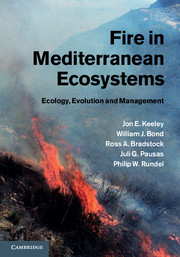Book contents
- Frontmatter
- Contents
- Section I Introduction
- Section II Regional patterns
- Section III Comparative Ecology, Evolution and Management
- 9 Fire-adaptive Trait Evolution
- 10 Fire and the Origins of Mediterranean-type Vegetation
- 11 Plant Diversity and Fire
- 12 Alien Species and Fire
- 13 Fire Management of Mediterranean Landscapes
- 14 Climate, Fire and Geology in the Convergence of Mediterranean-type Climate Ecosystems
- References
- Index
14 - Climate, Fire and Geology in the Convergence of Mediterranean-type Climate Ecosystems
from Section III - Comparative Ecology, Evolution and Management
Published online by Cambridge University Press: 05 January 2012
- Frontmatter
- Contents
- Section I Introduction
- Section II Regional patterns
- Section III Comparative Ecology, Evolution and Management
- 9 Fire-adaptive Trait Evolution
- 10 Fire and the Origins of Mediterranean-type Vegetation
- 11 Plant Diversity and Fire
- 12 Alien Species and Fire
- 13 Fire Management of Mediterranean Landscapes
- 14 Climate, Fire and Geology in the Convergence of Mediterranean-type Climate Ecosystems
- References
- Index
Summary
Integrating Climate, Fire and Geology in a Fire-prone World
Fire challenges the long-standing hegemony of ecology, biogeography and paleoecology that climate and soils are sufficient to explain the origin and distribution of plant species. In a world where half of the land surface is fire-prone (Krawchuk et al. 2009), understanding the past and predicting the future requires a close integration of climate, fire and geology. The dogma that fire is an anthropogenic phenomenon of little use in understanding paleoecology (Axelrod 1980, 1989), or merely incidental to vegetation development (Hopper 2009), is rapidly being replaced with a better understanding of paleofire's impact on land plant evolution (Scott 2000; Pausas & Keeley 2009). Attempts to model future global vegetation patterns have been demonstrated to be inadequate without including both natural and anthropogenic fire regimes (Bond et al. 2005).
Bond and Keeley (2005) outlined the conundrum posed by alternative explanations for the present distribution of vegetation and assembly of communities. Classical explanations have invoked resource-based mechanisms that are driven by climate and soils. There are ecosystems where resource-based mechanisms may be sufficient, but on many seasonally dry landscapes ecosystem processes such as fire play a major role in the organization and evolution of vegetation.
- Type
- Chapter
- Information
- Fire in Mediterranean EcosystemsEcology, Evolution and Management, pp. 388 - 397Publisher: Cambridge University PressPrint publication year: 2011



